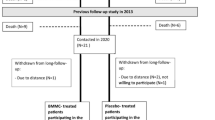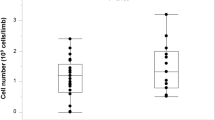Abstract
Emerging evidence suggests that bone-marrow-derived stem and progenitor cells can be used to improve cardiac function after acute myocardial infarction. We tested this concept in the randomized, controlled, BOOST (bone marrow transfer to enhance ST-elevation infarct regeneration) clinical trial. Following successful percutaneous coronary intervention for acute ST-elevation myocardial infarction, patients received an intracoronary transfer of autologous bone marrow cells (BMCs). After 6 months, global left ventricular ejection fraction, as determined by magnetic resonance imaging, was significantly improved in the BMC-treated group compared with the control group. BMC transfer enhanced left ventricular systolic function, primarily in myocardial segments adjacent to the infarcted area, and also had a positive effect on diastolic function. BMC transfer did not increase the risk of adverse clinical events and did not promote in-stent re-stenosis or proarrhythmic effects. In principle, the effects of BMC transfer on ejection fraction were sustained at 18-month follow-up. Notably, radioactive labeling of BMCs and positron emission tomography showed that these beneficial effects are achieved with limited cardiac homing of BMCs after intracoronary application. Taken together, our studies indicate that intracoronary transfer of autologous BMCs is a safe, promising, and novel approach to further improving systolic function in patients with successful reperfusion after acute myocardial infarction.
This is a preview of subscription content, access via your institution
Access options
Subscribe to this journal
Receive 12 print issues and online access
$209.00 per year
only $17.42 per issue
Buy this article
- Purchase on Springer Link
- Instant access to full article PDF
Prices may be subject to local taxes which are calculated during checkout



Similar content being viewed by others
References
Orlic D et al. (2001) Bone marrow cells regenerate infarcted myocardium. Nature 410: 701–705
Kamihata H et al. (2001) Implantation of bone marrow mononuclear cells into ischemic myocardium enhances collateral perfusion and regional function via side supply of angioblasts, angiogenic ligands, and cytokines. Circulation 104: 1046–1052
Kocher AA et al. (2001) Neovascularization of ischemic myocardium by human bone-marrow-derived angioblasts prevents cardiomyocyte apoptosis, reduces remodeling and improves cardiac function. Nat Med 7: 430–436
Yoon YS et al. (2005) Clonally expanded novel multipotent stem cells from human bone marrow regenerate myocardium after myocardial infarction. J Clin Invest 115: 326–338
Strauer BE et al. (2002) Repair of infarcted myocardium by autologous intracoronary mononuclear bone marrow cell transplantation in humans. Circulation 106: 1913–1918
Assmus B et al. (2002) Transplantation of Progenitor Cells and Regeneration Enhancement in Acute Myocardial Infarction (TOPCARE-AMI). Circulation 106: 3009–3017
Fernández-Avilés F et al. (2004) Experimental and clinical regenerative capability of human bone marrow cells after myocardial infarction. Circ Res 95: 742–748
Wollert KC et al. (2004) Intracoronary autologous bone-marrow cell transfer after myocardial infarction: the BOOST randomised controlled clinical trial. Lancet 364: 141–148
Hofmann M et al. (2005) Monitoring of bone marrow cell homing into the infarcted human myocardium. Circulation 111: 2198–2202
Wollert KC and Drexler H (2005) Clinical applications of stem cells for the heart. Circ Res 96: 151–163
Author information
Authors and Affiliations
Corresponding author
Ethics declarations
Competing interests
The authors declare no competing financial interests.
Rights and permissions
About this article
Cite this article
Drexler, H., Meyer, G. & Wollert, K. Bone-marrow-derived cell transfer after ST-elevation myocardial infarction: lessons from the BOOST trial. Nat Rev Cardiol 3 (Suppl 1), S65–S68 (2006). https://doi.org/10.1038/ncpcardio0407
Received:
Accepted:
Issue Date:
DOI: https://doi.org/10.1038/ncpcardio0407
This article is cited by
-
Cardiac Stem Cell Therapy and Arrhythmogenicity: Prometheus and the arrows of Apollo and Artemis
Journal of Cardiovascular Translational Research (2008)



